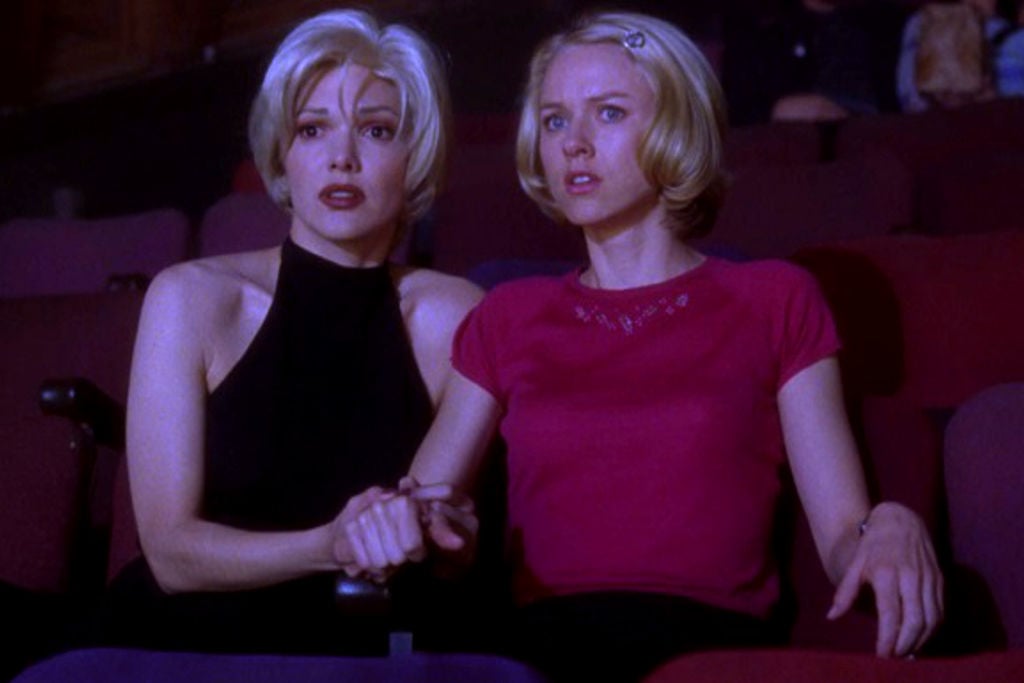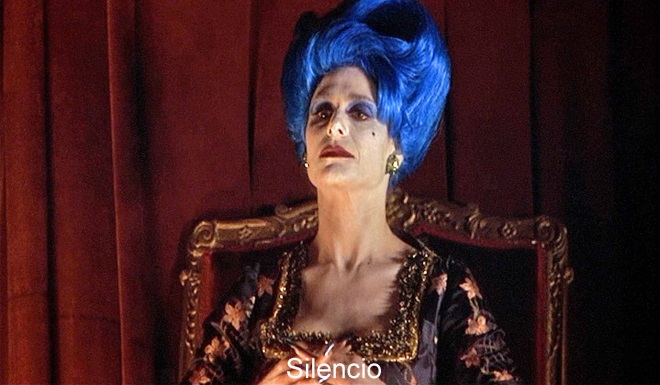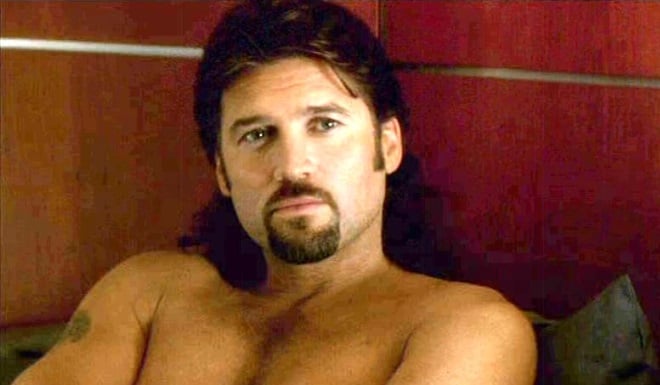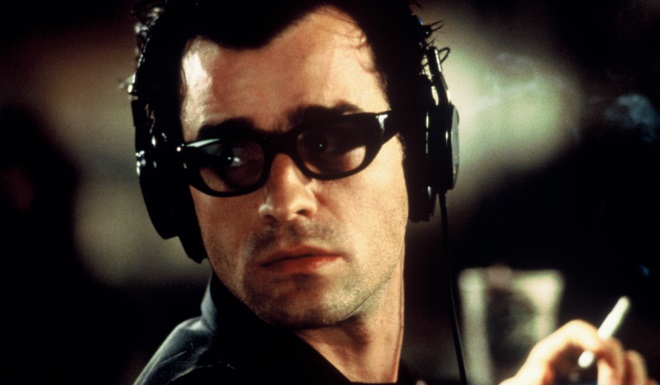Revisited: What Is It That Makes ‘Mulholland Drive’ So Good?
Fifteen years after its ill-fated pilot, we take a look back at David Lynch's greatest work. Contains spoilers.

This article contains spoilers.
–
Seen Mulholland Drive before? Great. Next time you’re lying in bed, cycle the following terrifying images through your head: the grubby, death-bringing bum behind Winkie’s diner; that old couple grinning madly in the back of a limousine; Rebekah Del Rio collapsing after lip-syncing her own Spanish-language rendition of Roy Orbison’s ‘Crying’; a disastrous tangle of vehicular carnage atop the titular, twisted Los Angeles highway; a half-naked Billy Ray Cyrus.
Congratulations. Sleep will not come to you this night.
If you’ve never seen David Lynch’s 2001 masterpiece before, that last paragraph will seem totally incomprehensible. Don’t panic: this indicates only that you are still sane. Even those who have seen Mulholland Drive struggle to understand what those chilling tableaus represent. But seeing them means falling under their spell, and even if sense can’t be made of its sequences, their visceral punch is undeniable, and the meaning they impart is profound. As the actor Michael J. Anderson (aka this guy) once opined: “David’s work isn’t consciously coherent… but its coherence on an unconscious level is inescapable — almost against your will.”
See? You don’t need to force yourself to recall its more memorable moments before bed. Mulholland Drive is always waiting there in the back of your mind, ready to spook you and sadden you when you least expect it.
Anyway, let’s take a step back.
Mulholland Drive is a two-part odyssey wherein Naomi Watts’ idealistic actress Betty enters the “dream place” of LA, only to find it morph into a waking nightmare before her eyes. Confounding, confronting and completely absorbing, it earned Lynch a Best Director Oscar nomination, as well as the Grand Prix and Best Director prizes at Cannes. In my opinion, it’s the finest thing he’s ever done, topping such other achievements as Blue Velvet, Eraserhead, and Wild at Heart and that arc on Louie.
However, two years prior to its release — fifteen years ago this year — Mulholland Drive was just a TV pilot for ABC Studios. And pilots suck, nearly without exception. Only a handful of shows have great pilots: Friday Night Lights, The West Wing, The Sopranos (pretty much)… and Twin Peaks. That too came from Lynch’s incredible imagination, and upon its debut in 1990, was an immediate pop culture phenomenon. Audiences were intrigued by the search for young Laura Palmer’s killer, in a mysterious locale where seemingly everyone had a secret, if not an actual affiliation with the supernatural. Less than one year later, in not-so-coincidental synchronicity with increased viewer frustration, ratings for Twin Peaks nosedived, and it was unceremoniously axed. Few shows shone so brightly, and so shortly.
Point being: ABC wanted Lynch to replicate Twin Peaks (well, its first season, anyway) not realising what they might actually be asking for. He delivered a two-and-a-half-hour puzzle as a pilot, seeing no problem with that in the slightest. The studio needed answers, or an idea of the season’s arc; Lynch refused to divulge unless they committed to his vision and picked up the entire season. It was a bold gambit that didn’t pay off. They tinkered with the pilot until it lost its Lynch-ness, and still decided to go, “nah”. Shows they picked up that year instead: Oh Grow Up, Wonderland, and something called Snoops. Yeah, they were all axed immediately anyway.
Join me as I travel the long, strange, tangled path of Mulholland Drive: from almost-forgotten footnote in a true master’s career, to his crowning achievement.
–
Mulholland Drive, Starring Audrey Horne
The way Sherillyn Fenn tells it, Mulholland Drive was originally conceived as a Californian-set spin-off for her Twin Peaks character, Audrey Horne. For those unfamiliar with the program (how dare you), Audrey was a sex-kittenish pin-up curiously trapped in the wooded labyrinth of Twin Peaks. As the show rolled along, she became its most sympathetic and endearing character; a good-hearted teenager harbouring a crush on MacLachlan’s straight-laced FBI agent and eventually burdened with a subplot that featured too much Billy Zane.
David Lynch didn’t comment on whether or not Horne was indeed the inspiration for Watts’ Betty. He didn’t need to. Audrey had two sides — sweetly innocent and provocatively manipulative — and so too does Betty. On the set of Twin Peaks is likely where the seed of inspiration for Mulholland Drive was planted. Imagine if Fenn had been given a whole, seductive show to herself? I don’t think any hormone-having person would have been able to handle it.
–
Naomi Watts: Giving Cinema’s Best Ever Performance?
Then-unknown Aussie actress (and Nicole Kidman bestie) Naomi Watts scored the plum role of Betty in the pilot; a small-town jitterbug-champ who apparently floated to LA on a cloud of hopes and dreams, only to immediately find an amnesiac car crash victim, Rita (Laura Elena Harring), residing in her aunt’s Old Hollywood apartment. Betty, with Nancy Drew enthusiasm, pledges to help Rita recover her true identity. Neither likes what they find.
Watts reportedly claimed she was glad the pilot wasn’t picked up, as Betty (in that form) was “one-dimensional” and only became fully-rounded once the third act was introduced in the movie. And yet, it’s in the pilot where she gets her most stirring scene: an audition for a cheesy, Lolita-lite melodrama in which she twists the dialogue into something both sensual and hugely troubling. Couple that with her incredible 180-degree turn in the flick’s final sequences, and the following becomes readily apparent: Naomi Watts is giving one of cinema’s best ever performances here.
While we’re getting hyperbole out of the way: the bit where we meet the bum behind the diner?
Yep, that’s the scariest thing I’ve ever seen.
–
From “Tits And Ass” To “Butts And Boobs”: The Watering Down Of David Lynch
Before Justin Theroux was one of The Leftovers, he played director Adam Kesher in Mulholland Drive, the put-upon filmmaker instructed by higher powers to cast a specific actress in his new feature, despite his protestations. If he was seeking inspiration, he needed only look at ABC’s treatment of David Lynch during the shooting of the pilot.
Years earlier — after the disastrous dénouement of Twin Peaks and the cancellation of his sitcom (!) On the Air –– Lynch scrawled ‘I WILL NEVER WORK IN TELEVISION AGAIN’ on a plywood board. He obviously warmed up to the idea again in 1999, even though he’d come to regret it. ‘Creative Differences’, a profile from the New Yorker, detailed the shooting of Mulholland Drive’s pilot, which began with overwhelming confidence on ABC’s part, beginning with a $4.5 million commitment.
The process was eventually poisoned, from Lynch’s perspective, when they made him sit in a room with 20 executives and take notes such as: “change all references of ‘tits and ass’ to ‘butts and boobs'”. Recently, Theroux reflected on the ridiculous constraints they put on his character’s smoking, insisting that Adam not smoke, and then, after Lynch complained, allowed Adam to smoke if he mentions trying to quit, while also suffering from “a cough — like a hacking cough”. The writing was on the wall: Mulholland Drive: The Pilot would suffer death by a thousand coughs.
The execs hated what Lynch had made – especially in its 150-minute form – so he reluctantly agreed to cut it down to 88 minutes. And still, they passed, fearing what viewers would think of this nutty, nightmare collage. If I was Lynch, I would have scoured my garage for that old plywood board…
–
Third-Act Twist
Rather, Lynch wrote 18 further pages, developed a love-story between the two female leads, Betty and Rita, and got the gang back together to shoot the additional scenes the following year. Most of it can be seen in the finale, which has Betty (spoiler alert) summoned back to the land of the living and awaken as Diane Selwyn, a spurned lover of Rita suffering severe hallucinations.

Lynch, obviously, won’t give an official explanation, though he did provide a guide to unraveling the mystery in DVD releases. His #1 hint gives the whole game away: “Pay particular attention to the beginning of the film: at least two clues are revealed before the credits”. It’s before the credits that the camera woozily lands on a pillow, indicating that the picture’s fantastical, illogical first half might actually be Diane’s drug-enhanced dreams. In the last act’s reality, she is a failed actress with a nasty crush on Rita, and Rita is a manipulative femme fatale who doesn’t actually reciprocate those romantic feelings, as Diane once fantasised.
So much of the movie’s early horror is Diane’s subconscious (serious spoiler alert) struggling to deal with her guilt over the decision to have Rita and her real-life lover, Adam, killed. Betty is a good actress and a good person. Diane can only be those things in her imagination.
Mulholland Drive is maddeningly abstract and inscrutable on first viewing, but hypnotic and haunting on every viewing after. Half folksy and half freak show, it allows its maestro to use Los Angeles as the easel for his disorienting visual style, and is an excellent showcase of his inimitable approach to dialogue. (Oh, and if you need another reason to love it, Billy Ray cites his involvement for indirectly giving Miley her career.) Salvaged from studio notes about cigarettes and “butts”, it was turned into a mesmerising portrait of heartbreak, jealousy, broken promises, and how Hollywood chews up and spits out its creative types. Lynch should know. No wonder he spends all his time doing Transcendental Meditation these days.
–
Simon Miraudo is Quickflix‘s AFCA award-winning news editor and film critic. He is also co-host of The Podcasting Couch and tweets at @simonmiraudo.


